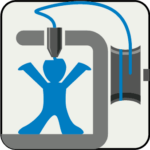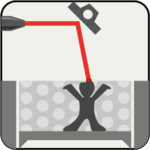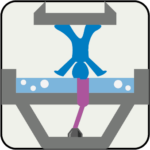Please select a printing method:
Are you still unsure about the choice of material or technology? Our support team will be happy to help you.
Make your request directly here.
3D printing service: SLA, SLS and FDM printing processes compared
If you are looking for a professional 3D printing service, you have come to the right place. We offer high-precision, high-quality 3D printing solutions using the latest printing technologies: SLA, SLS and FDM. In this article, we explain the differences between these processes and their benefits to help you choose the best printing process for your needs.
SLA printing (stereolithography) for your 3D printing service
Description:
- SLA printing uses a UV laser to cure liquid photopolymer resin in a container layer by layer. The printer moves a build platform down so that each new layer of resin is cured until the object is complete.
- This process enables the creation of highly detailed and smooth surfaces.
Advantages:
- High resolution and detail accuracy: Ideal for detailed and complex geometries.
- Smooth surfaces: The cured resin layers ensure a very smooth surface.
- Variety of materials: There is a wide range of resins, e.g. flexible, hard or heat-resistant resins.
SLS printing (selective laser sintering) for robust 3D printing
Description:
- In the SLS printing process, a laser is used to fuse powder material (usually nylon or TPU) layer by layer. The laser sintered the powder by heating and bonding it at the desired points. After each layer, a new layer of powder is applied until the object is complete.
- The unsintered powder serves as a support for complex structures.
Advantages:
- High strength and resilience: SLS-printed parts are often very robust as they are made of strong plastics such as nylon or flexible TPU.
- No support material required: the surrounding powder acts as a support, eliminating the need for complex support structures.
- Complex geometries: Enables the printing of complex geometries and interlocking parts.
FDM (fused deposition modeling) printing for cost-effective 3D printing solutions
Description:
- In FDM printing, a thermoplastic thread (filament) is melted through a hot nozzle and extruded in layers onto a building platform. The print head moves in the X and Y directions, while the platform moves in the Z direction to build up the object.
- This technology is particularly widespread and ideal for home and office applications.
Advantages:
- Cost-effective: FDM printers and materials are relatively inexpensive and widely available.
- Easy operation: User-friendly and requires less maintenance and calibration.
- Versatility in materials: Large selection of filaments such as PLA, ABS, PETG and special blends.
Comparison of the benefits for your 3D printing service
| Feature | SLA | SLS | FDM |
|---|---|---|---|
| Attention to detail | Very high | High | Medium |
| Surface quality | Very smooth | Uniformly rough | Visible layers |
| Variety of materials | Various resins | Nylon, TPU | Many thermoplastics |
| Strength | Medium | High | Medium to high (depending on filament) |
| Complex geometries | Good | Very good (without support structures) | Medium (with support structures) |
| Costs | Higher | Moderate | Low |
| Areas of application | Prototyping, tabletop figures, jewelry | Functional parts, prototypes, end-user parts | Prototyping, end user parts |
Our 3D printing service offers you customized solutions for your individual requirements. Whether you need high-precision prototypes, robust functional parts or cost-effective end-user parts – we have the right printing process for you. Contact us now and let our experts advise you!
Still not sure which printing process is right for you? Our material finder will give you a quick overview. Click here
Order 3D printing online: the flexible service for your project
3D printing is increasingly coming into focus, particularly in the production of prototypes. It is considered flexible to use and precise, but also impresses with its price structure. In recent years, the technologies available for 3D printing have undergone continuous development, resulting in a steady improvement in quality. If you would like to order 3D printing online for the realization of your projects, you have come to the right place. We are at your side with our expertise and an excellent range of products.
Order 3D printing online: these processes are available to choose from
When you order your 3D print from us, there are various processes to choose from. All of them have their own advantages, but also weaknesses. For example, you can opt for FDM printing. Here you benefit from particularly low prices, but also from a large selection of materials. SLS printing is also available to you. It scores points with its strong layer adhesion and outstanding freedom of shape. The third process is SLA printing. SLA printing is the best choice, especially if you want to order a 3D print that requires a large number of details. We recommend this process for figures and illustrative objects.
Do you still have questions?
Do you have any questions about the technologies we use and their special features? Then get in touch with us! We will be happy to advise you and show you what special features you can expect from us. For example, we can help you to select the right printing process for your requirements to suit your preferred materials.




